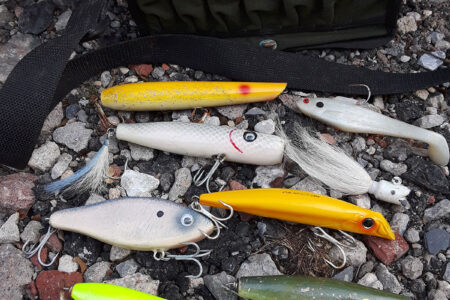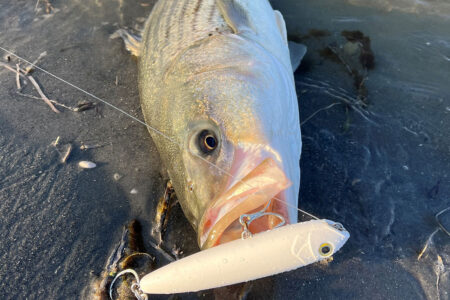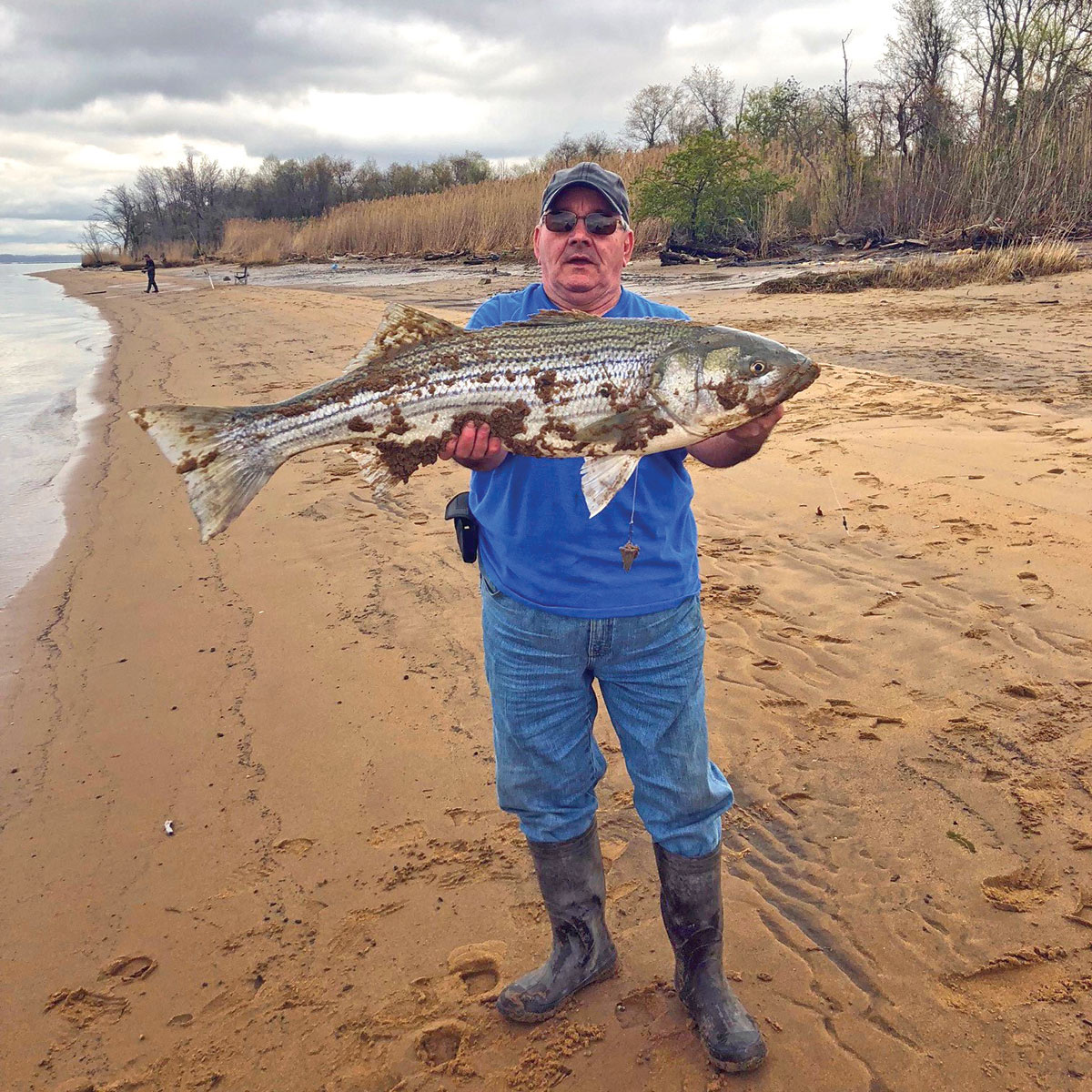
New Jersey’s back bay season has officially reopened for business!
Back bay sod banks are rock hard, comprised of crystallized ice and even maybe a little bit of snow covering. But that doesn’t mean anglers aren’t getting geared up for the first shot of striper fishing in the backwaters.
March 1 signals opening day for back bay stripers; and while most bass in early March will be smaller schoolie resident fish that have wintered over in the salt creeks, anglers search out the first wave of larger migratory fish that usually moves up into the area during the second week of April.
By the time May rolls around, the game is officially on with some of the largest linesiders of the year crashing through.
Early season locales in March and April aren’t secret back-pocket spots but well known historical haunts for opening day stripers. New anglers may think they are newly discovered, but older bankcasters will recognize the familiar names. Regardless of spots, the key is to understand what makes stripers come through at a certain time and place and why.
To sum up bass habits anywhere along the Jersey Coast, it goes a little like this – 48-degree and warmer air temps, outgoing tides, and muddy bay waters that soak up the sun’s warming rays, and you can position yourself just about anywhere to find striped bass in March and early April.
That said, here are a half-dozen “spots” to zero in on during the months of March and April in terms of tackling early season stripers.
Raritan Bayshore
The Raritan Bayshore teems with early bass opportunity. Shallow, muddy backwaters warm up faster than ocean sands during early spring sun, sparking first wave and resident stripers to move in and feed. Cliffwood Beach boasts craggy sod banks that attract bass on higher tides, but can be navigated carefully on lower tides as well. The sod banks house homes for sandworms, bloodworms and tapeworms, which in turn attract bass to the area to come feed. Brick-laden Pebble Beach contains plenty of debris from the old brickyards, which crustaceans, sea worms and copepods come to attach and habitat around, therefore bringing in bass. Union Beach has myriad back creeks that empty into the pay where outflowing tides pour forage into the surrounding shallow bay waters.
The Tactic – Bait up with fresh clams, sand worms, bloodworms and tapeworms. A three-way swivel and sinker clip, 28-inch shot of 40-pound fluorocarbon leader, and a size 2/0 to 5/0 baitholder hook on the end, smaller size hook for worms, larger for clams. Both high and low tide hours are prime here, but know that the night time fishery here in March and April is top notch. Don’t simply fish during daylight, hit the dark hours for the best bite.
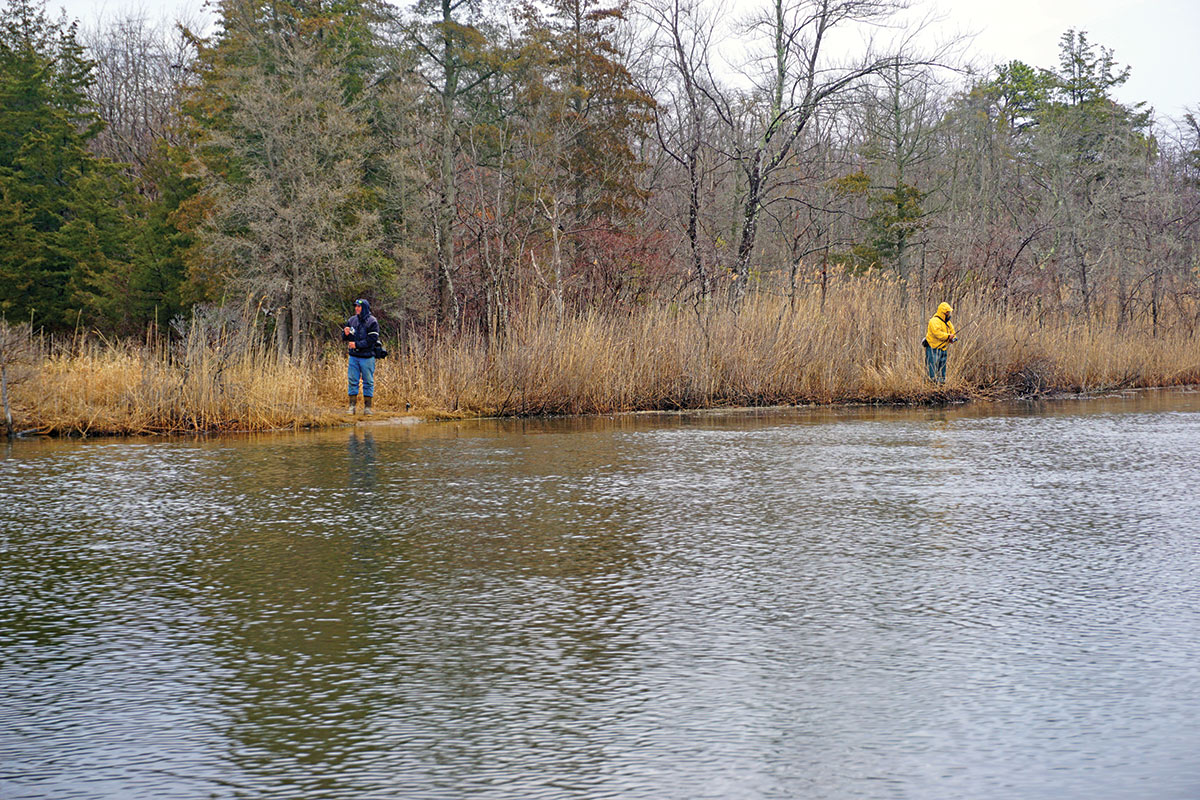
Toms River
Toms River flows out into Barnegat Bay, where night time excursions are literally lights out for bass fishing. Bass move through on the outgoing tides here and feed under the guise of darkness. Many accessible dock points from the confluence at Barnegat Bay exist from Island Heights all the way back to Huddy Park; a bonus here is you can score with white perch during this time of year using the same rigs.
The Tactic – Hi-lo rigs fixed with small size #6 to #4 hooks and small quarter-inch pill floats work for rigs here, equipped with a light 1- to 2-ounce bank sinker. Use 1- to 3-inch bits of sandworms or bloodworms as baits to lance on the hook, and the tiny floats will keep the worms off the river bottom and into the strike zone of passing bass as they move in and out with the tides. Don’t forget to bring the clip-on Cyalume night light sticks to detect strikes during the dark hours.
Graveling Point
It’s a keeper! You always hear of the first legit 28-inch plus bass coming out of Graveling Point, even though Raritan Bay can give that early season honor a run for the money. Graveling Point is tops as it exists as the confluence of where the Mullica River empties into the shallow water of Great Bay, creating a swashing cut that attracts stripers. A severe cut rips off the end of the point, which provokes bass to come feed when water temperatures generally hover around the mid 40s to 50s, with the magic temp number usually being around 48 degrees when the bass will open their mouths to gobble up a bloodworm, grass shrimp, sandworm or clam bait. Outgoing tides are better to fish in the spring as the sun warms up the baywaters first and it empties out triggering a few degree rise in water temps that get bass more actively feeding.
The Tactic – Fishfinder slide rig including a braid-friendly fishfinder slide sinker clip, a 75-pound barrel swivel, 24-inch shot of 30-pound fluorocarbon leader and a size 2/0 baitholder hook on the end. A 2- to 5-ounce pyramid or bank sinker is clipped onto the slide.
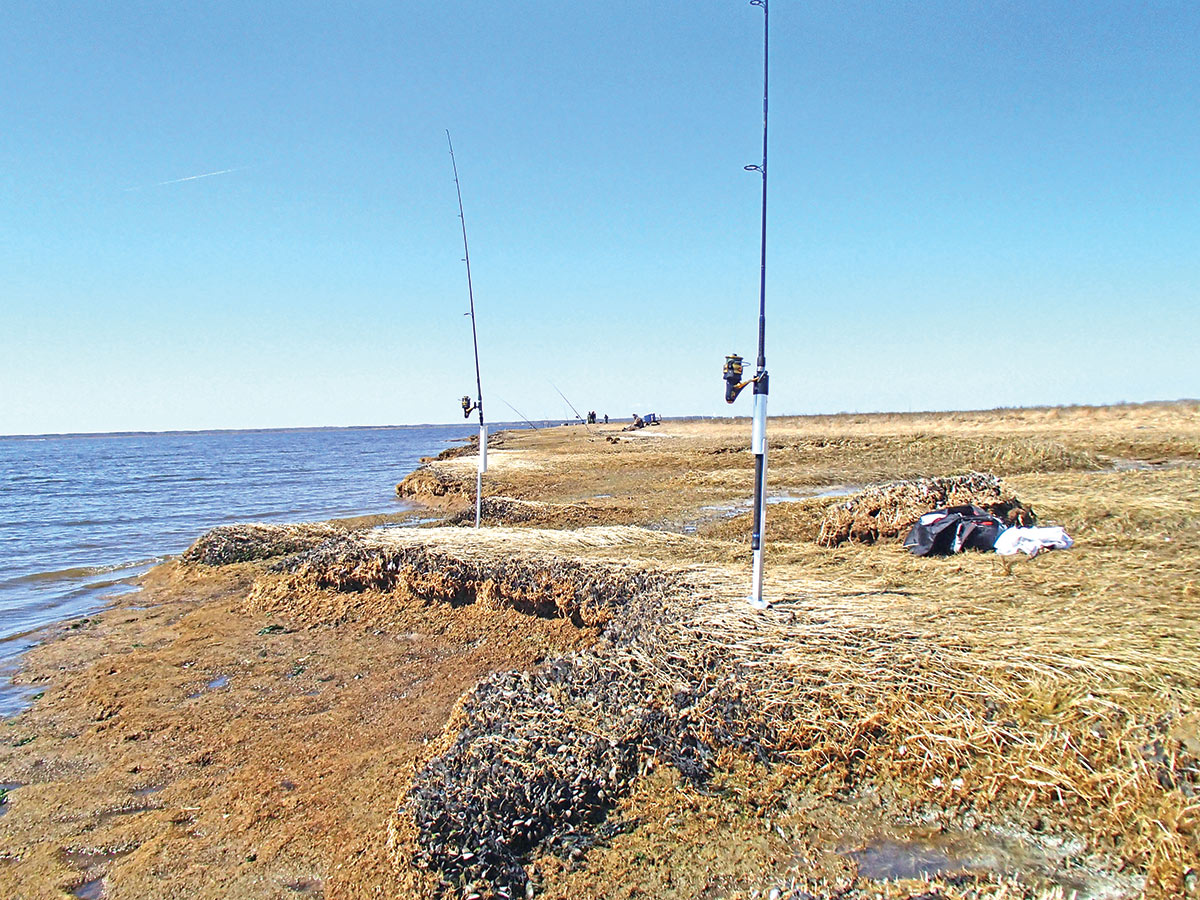
Great Egg Harbor River
South Jersey anglers gravitate toward the Great Egg Harbor River as it spills into the Great Egg Harbor, boasting depths of up to 50 feet along its stretches. Way upstream, the Mays Landing area bulkheads provide plenty of big bass opportunity during the spawn, as larger linesiders up to 25 pounds can move up and in during April. At the delta of the river where it empties into the Great Bay, Jeffer’s Landing is an accessible walk on spot to toss lines in. In the days of old, herring was the top forage for bass entering the river, but those days seem to be long gone. Nowadays, worming or shrimping is the best way to hang a linesider.
The Tactic – Most early season anglers cast grass shrimp, sandworms or bloodworms from the banks. Opt to toss smaller 1/0 to 2/0 baitholder hooks with tiny pill floats affixed above. Thread the worms or shrimp on up to cover the shank of the hook and cast out into the current. If herring is legal to use during any given year, by all means liveline them back out from the banksides, especially in the upper portions of the river during the striper spawn.
Delaware Bayshore
Along the Delaware Bayshore, the pebbly sands comprised of Cape May Diamonds along with mudflat areas make up most of the Bayshore shoreline. Fortescue Beach is the stopover for stripers on the migratory highway up into the Delaware River. Usually the first week of April has bass on the chew at Fortescue, but the bite seems to move downbeach to Reed’s Beach as late April and early May roll in. Keep in mind that the north side of the Delaware on the Jersey side gets more of that southern sun exposure so the bite often gets better there before it does on the south side at the beaches at Bowers or Broadkill.
The Tactic – It’s all about bloodworming in Delaware Bay. Cast out hi-lo rigs fixed with size 2/0 baitholder hooks and lance worms on whole so they flutter on the bay bottom.
Delaware River
One of the world’s three major spawning grounds for striped bass, the Delaware River is an absolute hot spot to hit during the spring run. While bass loaded with eggs will cruise way upstream, a few of the main areas where anglers gravitate to intercept the migratory fish include the DOD, Elsinboro Point and Pennsville. Many times, cows up to 40 pounds can be taken from the rocky shorelines along the Big D.
The Tactic – Bunker chunking is a prime tactic here for larger linesiders. A standard chunk rig with a three-way swivel a 24-inch section of 40-pound fluorocarbon leader and a size 10/0 octopus circle hook is used to launch out a big chunk of bunker. If herring baits are allowed, by all means use herring. Bloodworm baits are a good second choice to float through the moving waters. Don’t forget the striper season closure along stretches of the Delaware from April 1 through May 30; to protect spawning striped bass, from the Calhoun Street Bridge near Trenton downstream to the Commodore Barry Bridge at Bridgeport in New Jersey, non-offset circle hooks must be used when using bait with a #2 sized hook or larger from April 1 to May 30 as striped bass must be released.
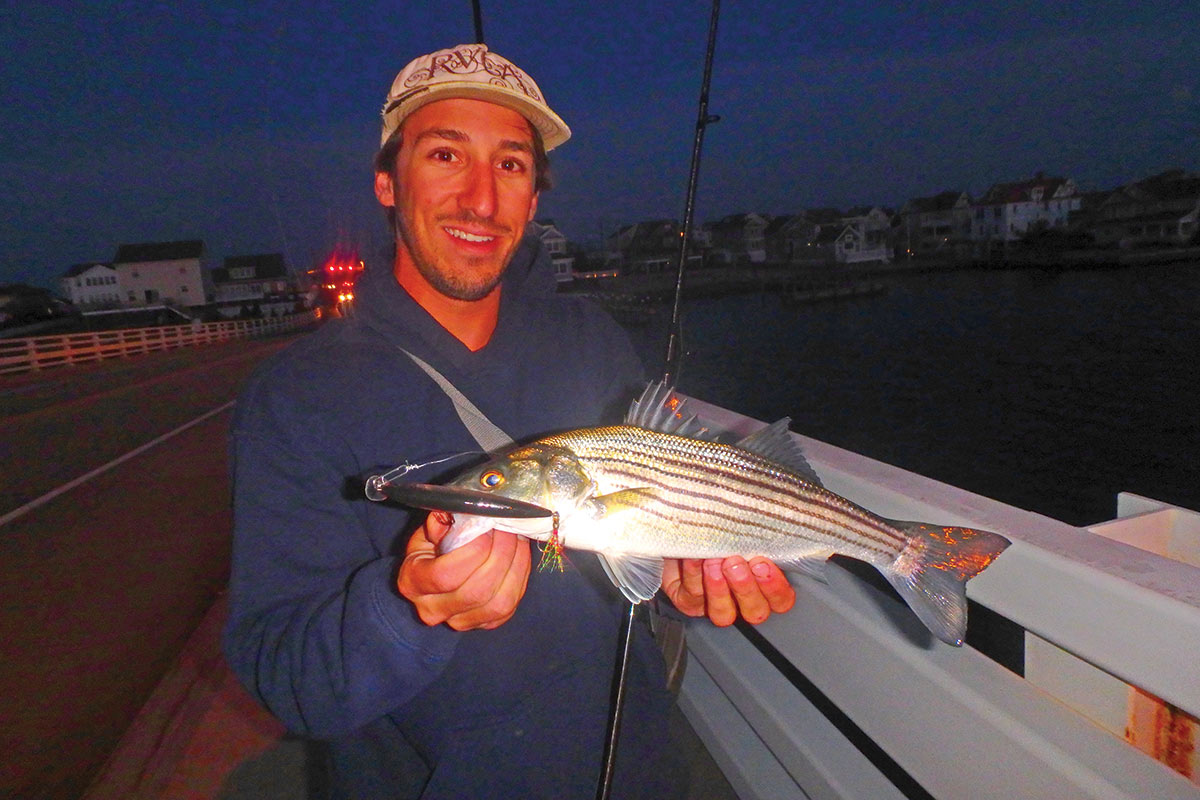
Action on “ice out” stripers in the backwaters are dictated mainly by water temps to start. The old school perennial warm water habitat oasis at the Oyster Creek Nuclear Power Plant outflow is now gone for good, so you’re going to have to put in your time to find the right temps and tides to find those early season stripers.
Follow the warming waters, put on the proper baits, and hit it hard for opening day striper success!


